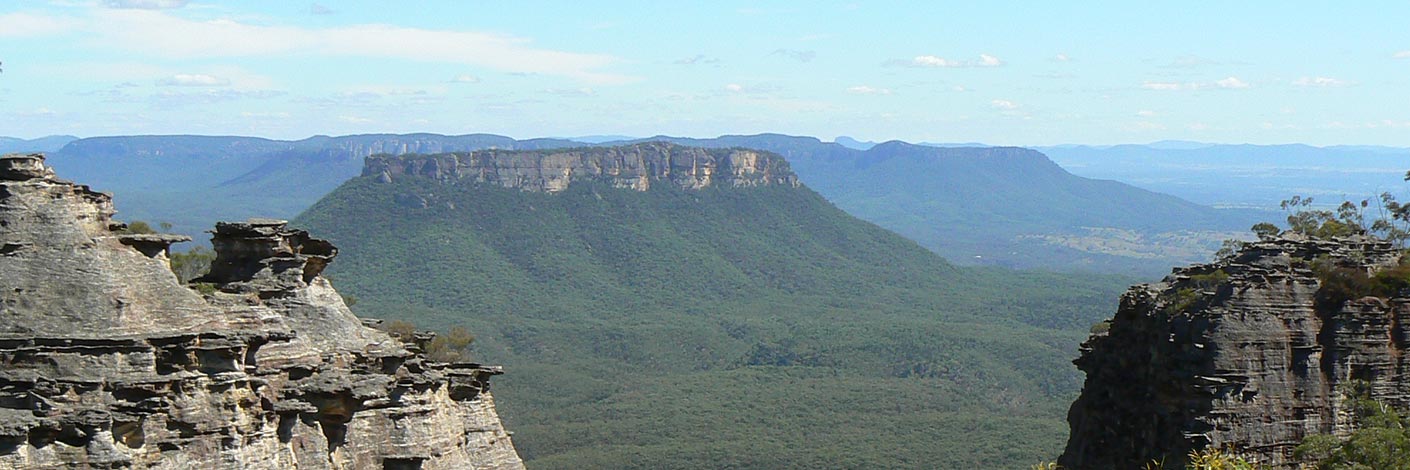Bush Explorers Encyclopaedia
Stick Ridge
Is a short, 2km ridge that has its northern end above the junction of Bungleboori Creek and Stick Canyon, and its southern end joining Ant Hill Ridge. Named by Peter Fox, National Parks Association bush walker, in 1995-1998.
Stillson Spur
Trends generally north south for one kilometre and has the northern end joining Crisscross Spur, which in turn trends off Waratah Ridge. So named by Michael Keats on a Bush Club walk, 20th July 2012, due to the find there of a large, 36" Stillson wrench.
Stockman Huts
There are two of these huts in the Wolgan Valley, one located below Wolgan Gap near the base of the hill and the other south of Wolgan Road opposite the cattle yards and close to the former Wolgan Cemetery. These huts were both built by Ray Fitzpatrick, 1951-1953. At the time Fitzpatrick owned 6,000ac in the valley, and both these huts were on his holding. Ref: Ian Coates, Wolgan Valley, telephone correspondence to Brian Fox, May 2016
Storm Wave Rock
Is an unusual rock formation located on the north west side of Mount Budgary. Named by Michael Keats on his Bush Club walk, 25th February 2009. So named as the 3D erosion pattern gives the appearance of a wild, stormy sea.
Stringybark Valley
Is so named after the Stringybark Eucalyptus in this area. Named by Col Ribaux during his diamond mine construction period, 1961-1975. This small valley (gully) is a tributary of Genowlan Creek. 1.7km north east of Genowlan Trig. Ref: letter from Col to Capertee Valley Alliance, March 2011.
Striolata Point
Striolata Ravine is a 1.1km non perennial watercourse 2.5km north east of Birds Rock Trig. The last 200m before the cliff line contains a frieze of thousands of Orchids,Dendrobium striolatum.Above and on the northern side of this ravine, a wing like protrusion from the cliffs forms another major viewing point, Striolata Point. Both features named by Michael Keats on a Bush Club walk, 10th October 2013. The orchids were in full flower on that day.
Striolata Ravine
Is a 1.1km non perennial watercourse 2.5km north east of Birds Rock Trig. The last 200m before the cliff line contains a frieze of thousands of Orchids,Dendrobium striolatum. Above and on the northern side of this ravine, a wing like protrusion from the cliffs forms another major viewing point, Striolata Point 414 107 . Both features named by Michael Keats on a Bush Club walk, 10th October 2013. The orchids were in full flower on that day.
Submarine Rocks
See entry Centre of the Universe
Is the name given to a group of prominent pagodas 3.2km south east of Goochs Crater. Marked on the topo map as spot height 994. Known by this name by bushwalkers prior to 1990s. Graham Conden records the name in 1999 as Submarine Rocks, because when walking in from the Bells Line of Road, he felt as though you were on the conning tower of a submarine in the middle of the ocean.
Suboir Canyon.
'suboir" is a phonetic rendering of SUBW, Sydney University Bushwalkers. The SUBW archive records, that this canyon within Dumbano Creek was visited on the 30th March 1962, but it was not until 19-20th August 1995 that it was given the name Suboir Canyon. It is also known as Dumbano Tunnels or the Dumbano Dungeons.
Subsidence Row
Refers to a trail marked with subsidence warning notices running north south off Clarence Firetrail on Girdwood Ridge. Named by Peter Fox, a member of the National Parks Association, in the late 1990s.
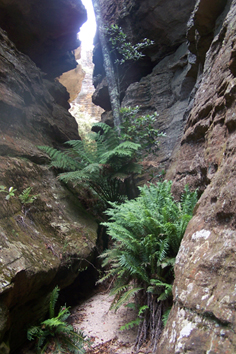
Sunnyside Canyon
Is located off Sunnyside Ridge Road via Fire Trail No. 8. This gully flows into Bushrangers Creek and above the western side of Sunnyside Canyon above the cliff line is the feature known as, Foxs Wedge.
Sunnyside East Swamp
Is located at the headwaters of Carne Creek between Sunnyside Ridge Road and Fire Trail No. 1. The southern part was originally known as see Dead Dog Swamp.
Sunnyside Gully
Is located between Sunnyside Point and Wolgan Pinnacle. It has its headwaters at the northern end of Fire Trail No. 7 on Sunnyside Ridge and generally flows north and north east for 2.6km to its junction with Carne Creek. Named by Michael Keats on a Bush Club walk, 11th July 2007.
Sunnyside Point
Is the most northerly point reached on Sunnyside Ridge via Fire Trail No. 7. This isolated rocky point (918m) has a commanding 360 degree view of the Wolgan Valley. An impressive viewing location within the Gardens of Stone National Park off Sunnyside Ridge Road. Named by Brian Fox on 6th August 2013.
Sunnyside Ridge *
This ridge is about 12km in length, trends generally north off the Blue Mountains Range. It divides the watersheds of the headwaters of the Wolgan River and Carne Creek. Highest point along this ridge is Birds Rock Trig Station at 1181m. Its northernmost point along Fire Trail No. 7 is at Sunnyside Point. Sunnyside was the previous name of Birds Rock Trig Station. The Trig name was in existence from 1930, so the name Sunnyside is prior to this date. Sunnyside Ridge was so named as this part of the ridge trends north south and hence the eastern side obtains the morning sunlight. Ref: Danny Whitty, Aboriginal descendant of this area, 19th February 2010.
Sunnyside Swamp
Is located at the headwaters of the Wolgan River between Campbells Road and Sunnyside Ridge Road.
Sunshine Cave
Is located 900m north east of Little Capertee Creek Camping Ground and 200m in height above the Wolgan River. It is a spectacular high cave, glowing in the sun, with rich, multi-layered, intricate sandstone decorations soaring 40m or more towards the blue sky above. Named by Yuri Bolotin and Brian Fox on a bushwalk 14 July 2017 as “It looked absolutely stunning in the morning light, and such a contrast to the shaded areas that preceded it. Such outstanding feature needed a name, so we decided to call it Sunshine Cave.”
Surefire Brook
Has its headwaters and tributaries on the eastern side of Deanes Plateau and western side of Heart Attack Brook. It flows generally in north east direction for about 5.5km till it joins Rocky Creek. Within this creek is the canyon called Surefire Canyon. So named asTom Williams suggested they did, "a surefire canyon", but mechanical problems and rain caused the trip to be postponed to the 1976 / 1977 canyon season. Ref: Kameruka Magazine, September 1977, Vol. 15. No. 1, pp. 10-11.
Suspended Barbican
Is located 400m south east of Genowlan Trig. A section of cliff line has parted from the main cliff and moved out about 30 to 50m. About 200m long this great block has a suspended floor about 80m down from the top. Walking access from the top is not possible. Named by Michael Keats on Bush Club walk, 1st June 2015. A barbican is, an outer fortification to a castle or town, a watchtower guarding a gate or drawbridge.
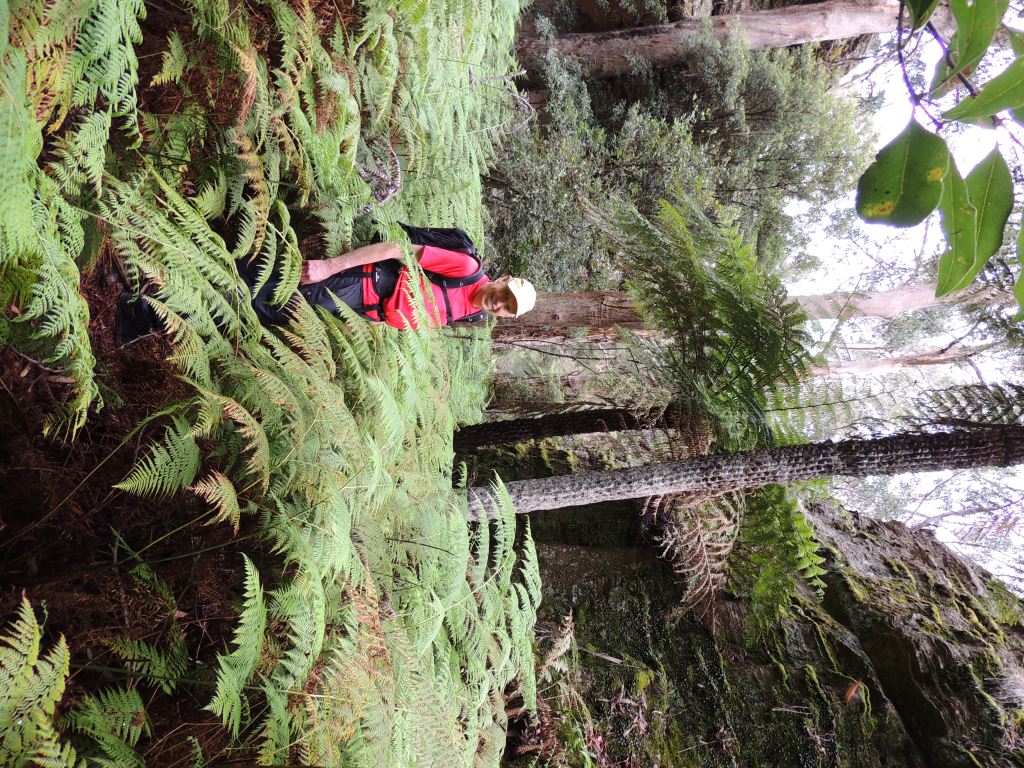
Sutherland Gully
Rises on the western side of Tiger Snake Canyon Track and 1km east of the Glowworm Tunnel. It flows for 2.5km generally north west through Coach Galleries over the Pagoda Track and railway alignment and into the Wolgan River. This gully dissects the plateau from the Glowworm Tunnel in the south and Point Sutherland on the north. Donald Sutherland was a Consulting Engineer and General Manager of The Commonwealth Oil Corporation Ltd mine and refinery at Newnes in 1906, at the time when the Wolgan Valley Railway was being constructed. Named on a Bush Club Walk by Michael Keats, Yuri Bolotin and Brian Fox, 27th January 2017.
Sweetwater Creek
Is immediately south of the location of the former hut on Mount Cameron, where permanent water could be found. This creek flows in a generally southerly direction for 1.7km into Nayook Creek. Ref: Interview with Dick Bird, 29th January 2010. Dick's father Jim held the lease in 1960s.
Tagine Point
Is located 2.6km south east of Birds Rock Trig Station. Michael Keats recorded on 13th March 2013," Looking at the last pagoda, a residual erosion piece, has reminded us of an oversize Moroccan tagine or cooking pot. It was so big, two of us could sit in it - great for pictures. This strange piece also had an irregular pair of narrow horizontal slot windows that could be used as picture frames. I have named this amazing place Tagine Point."
Tara Point
Is located at the top of Tara Slot an impressive narrow rocky projection above a right angled smooth sided cliff face. 900m south of Mount McLean. Named by Yuri Bolotin on 13th April 2013.
Tara Slot
Was named by Yuri Bolotin on 13th April 2013, when walking out from Hecates Cauldron towards Mount McLean Trail. Tara Cameron, an avid bushwalker and Vice President of Blue Mountains Conservation Society, found this incredible slot through the impossible cliffs that led us to a jaw dropping lookout, and then out on to the main ridge. Located 900m south of Mount McLean.
Tarpeian Rock *
Is a high and projecting isolated rock, 4.5km east of Ben Bullen and 1.1km south east of Rowans Hole. This name may have been derived from John Savery Rodd (1806-1870), who was one of the earliest land holders in the Capertee Valley; he purchased 640ac near Glen Alice in 1830. His Sydney residence at Potts Point was called Tarpeian. Ref: Palmer, Freda and Scurrah, F L. Tour of Rylstone and Capertee Valleys,1969, Pt: 2, p. 10. The name Tarpeian is associated with Tarpeian Rock; Capitoline Hill, Rome, Italy. Shown on the Parish Map of Ben Bullen, 1885. That aside, there is a similarity between the vertical faces of both the Tarpeian Rock in Rome and the Tarpeian Rock above Rowans Hole.
Tarrapalat
William Mylecharane (1832-1917) licensed surveyor, in 1892 recorded the Aboriginal name for River Lett at Hartley as, Tarrapalat. An 1913 article has the spelling as, Tarapalet. The 1892 definition implies that the whole of the River Lett was called Tarrapalat while the 1913 article restricts this placename to a smaller section of the river at Hartley, about 2 km upstream of the River Letts junction with the Cox River.
Gundungurra language authority Jim Barrett believes that the appropriate spelling of Therabulat would be, Dhurrabulat, which meanstwo rivers. He concluded that the two rivers referred to would be Coxs River and River Lett, and that the name properly applied to the Coxs River at, and locally below, the junction.
Ref: Smith, Jim. Does the Cox River have an Aboriginal name? Blue Mountains Historical Society, Hobby’s Outreach Vol. 28; No. 3, June – July 2016.
The Sydney Mail and New South Wales Advertiser, 12th December 1896, p. 1250, col. 4 records…..”the name Therabulat….according to Mr. James Neale, was corrupted by the whites to “The River Lett” and as such applied to a tributary of the Cox at Hartley”.
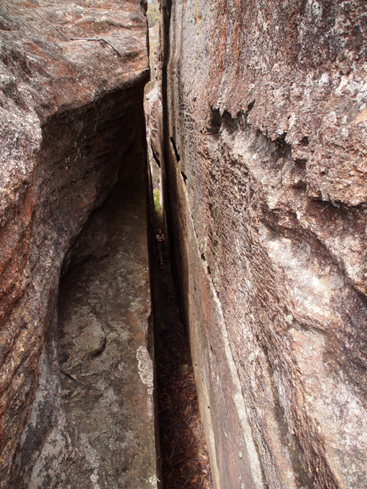
Tartarus Slot
Was named by Yuri Bolotin on a bush walk, 9th March 2013.This amazing, 50m long, narrow, deep slot is located on the western side of Zeus Ridge in Poseidon Arena. Yuri so named it in keeping with the Greek mythology theme of this area. Tartarus was a very deep and dark place in Greek mythology, just like the slot itself.
Telephone Pass
Gives access from the headwaters of Zobel Gully near the saddle with Constance Gorge to the top of the eastern cliff line. Located at the top of the pass on the base of a pagoda is the steel anchor point used to hold the telephone cable which was strung across the top of the gorge c1906. Named by Brian Fox on a Bush Club walk, 11th March 2016.
Telescope Rock
Is a natural ironstone tube horizontally mounted on a plinth above a pagoda, overlooking the valley below. It is located 1.5km north east of Invincible Trig Station. Named by Yuri Bolotin on a Bush Club walk, 15th August 2013.
Temple Bath
Refers to a rock like feature that looks like a bath. Located 60m on the northern side of Blackfellows Hand Trail within the area known as the Temples of Doom. Named by Freda Moxom in keeping with the Temple of Doom nomenclature on a bushwalk, 1 December 2016.
Temple Creek
Has its headwaters on the western side of The Temples of Doom and flows generally north, north east for 1.6km into the Wolgan River. Before this small non perennial creek flows over the cliff line, it passes through the features named, The Sacristy and The Catacombs. Named by Michael Keats on a Bush Club walk, 4th October 2013.
Temple of Doom
Is located on the northern side of Wolgan Road and 3km from the Wolgan Road and Blackfellows Hand Trail intersection. One of the taller pagodas located about 200m north of the road, GR 332 092, was given the name Temple of Doom by Haydn Washington, after the 1984 adventure film Indiana Jones and the Temple of Doom, directed by Steven Spielberg. Bushwalkers now refer to this whole area of the spectacular smooth, rocky pagodas in the plural, The Temples of Doom
Temple Slot
Located 500 m north west of the Temples of Doom, above Temple Creek and on a large, centrally disposed pagoda, which has been cleaved down the middle by a natural slot no more than 30 cm wide. The length is about 60 m and the depth over 30 m. The parallel sided walls curve in and out. Named by Harold Thompson on a bushwalk, 26th April 2016.
Tenochtitlan
Is a sculptural rocky pagoda like feature rising from the cliff lined face 100m south, south east of Mount Dawson. It was given the name Tenochtitlan by Oliver Crawford and members of the Sydney Bushwalkers Club. They have known this feature since the 1980s. The upper section has a sheltered spot for a campsite.Tenochtitlan was a major Aztec city in Mexico, now in ruins.
Ten Percent Slot
Is a 50m long slot where the width varies from 50cm to 3m; it gives access to the top of the mesa between Canobla Creek and Little Capertee Creek, Newnes. Located 1.1km south east of Point Nicholson. Named by Yuri Bolotin on a Bush Club walk, 20th April 2017, as Yuri mentioned to fellow bushwalkers, “According to the aerial map, this slot should not work either; I would give it a 10% chance, but we better have a look at it.” The slot is crowned by a series of pagodas, richly decorated with ironstone erosion residual sculptures. They offer spectacular views south into the Little Capertee Creek system and south west towards the Wolgan-Capertee Divide.
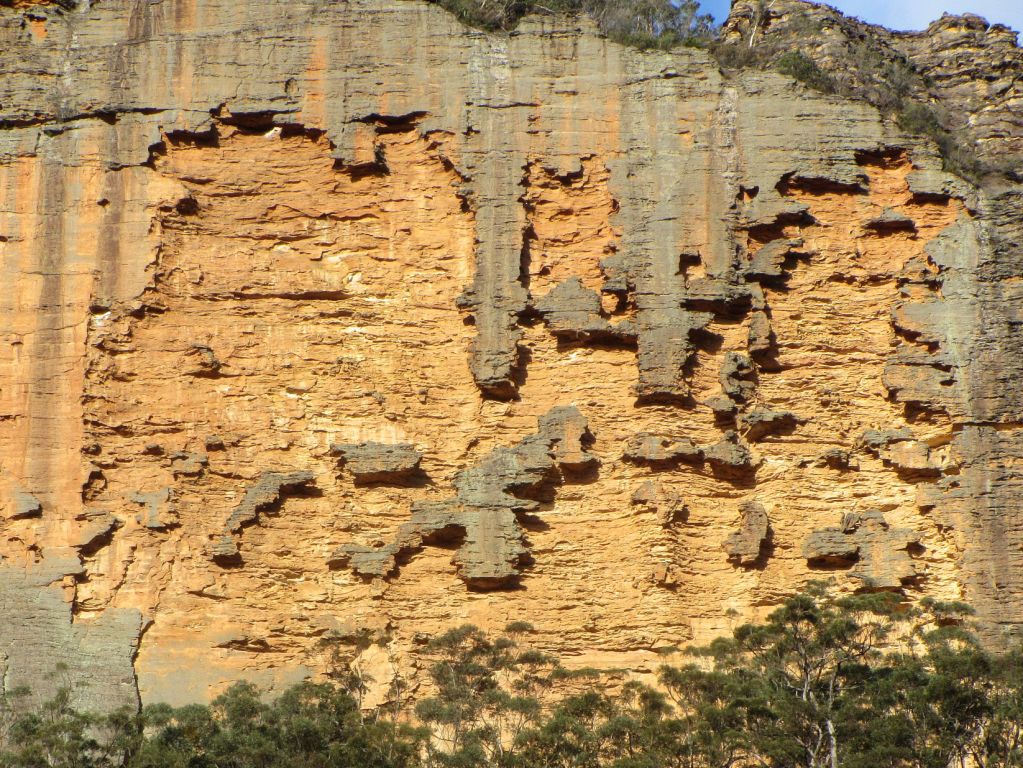
Tesseract Wall
Is located on the western cliff face of Zobels Spur, 850m north, north east of the Wolgan River and Zobels Gully junction. The weathering on the cliff face has resulted in an amazing embossed patchwork of shapes and patterns. Named by Erik Halbert on the 15th October 2016 as it reminded Erik of a mathematical construction.
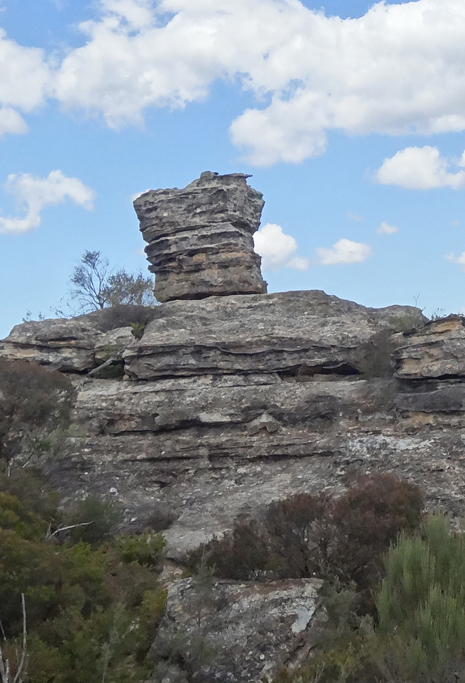
The Altar
Refers to a rocky square platform, 2m high, located at the end of Fire Trail No. 2 off Glowworm Tunnel Road. This is another location where one can be inspired by the natural beauty of sandstone erosion residuals. Named by Michael Keats on a Bush Club walk, 28th February 2007 due to the shape resembling an Old Testament Biblical altar. See also Lurline Jack Lookout.
The Amphitheatre
Is located 1.6km north east of Invincible Trig Station. Named by Yuri Bolotin on a Bush Club walk, 15th August 2013. Michael Keats recorded in his notes, " It was an amazing compound cliff and terrace area, ninety nine percent open eroded sandstone. The terrace had an apron like appearance that was readily climbable to the base of the cliffs."
The Arch
Accessis via Waratah Ridge Road and then by walking from the National Park barrier in a general easterly direction for 6.5km to the top of Arch Canyon. The arch, located about 100m above the junction of Arch Creek with the Bungleboori Creek, is massive and uniquely positioned parallel to Arch Creek. It has not been formed by water erosion but by internal block collapse. Behind The Arch is a perfectly rectangular void, making it a singular structure with well defined, almost geometric lines. The Arch is 30m from the top of the arch to the ground beneath, the opening is 15m wide; the almost level top is 1.5m wide while the connecting span of the bridge is 2.5m thick.
The Arena
Refers to the headwaters of Petries Gully, Newnes and the canyon like, fan array of cliffs which encompass this gully. Named by Thomas Ebersoll, owner of the old Newnes Hotel, 2011.
The Barnacles
Were so named by Ian Thorpe 27th November 2010, as the studded line of pagodas resemble barnacles on the side of a ship. Located above the southern side of December Creek, 3km north east of Bell. Approaching The Barnacles from the west and seeing them as a continuous line across the ravine from the Lesser Barnacles 491 908 the view is a panorama made more spectacular by the vertical cliff lines on the western edge.
The Bathtub
Located at the base of Cathedral Pass / Canyon this small waterhole has been dubbed, The Bathtub by Thomas Ebersol owner of Newnes old Hotel and cabins.
The Bicentennial National Trail.
Guidebook No. 9, Barrington Tops to Jenolan Caves, pp. 60-65, details the trail within the area of our interest, from Glen Alice via Pantoneys Crown, Baal Bone Gap to Lidsdale. The Australian Trail Horse Riders Association (ATHRA) was formed at a meeting in Gatton, Queensland in 1972. One of the objectives of this new organisation was to develop a trail that linked up the stock routes along the Great Dividing Range, thus providing an opportunity to legally ride and live the free lifestyle of drovers who once frequented the stock routes. The route was opened in November 1988. Ref: www.bicentennial nationaltrail.com.au.
The Breadknife
Is located near the mid section of Genowlan Mountain plateau 2.4km south of Genowlan Point. Walking access is via the 4WD track that traverses the spine of Genowlan Mountain plateau. Named by Colin (Col) Maxwell Ribaux, former local land owner, after the geographical feature The Breadknife located in the Warrumbungle National Park.
The Buffers
Refer to an impressive series of wind eroded overhangs above the headwaters of Tunnel Creek. Access via the Old Coach Road. Named by Michael Keats on Bush Club walk, 11th January 2016.
The Catacombs
Is the place where Temple Creek enters a series of tunnels that twist and wind and rise and fall. Some are dry and some are just damp. All are totally captivating. This tunnel complex extends for about 200m downstream to GR 329 097. In keeping with The Temple of Doom theme, Michael Keats so named it on a Bush Club walk, 4th June 2013. Beyond The Catacombs is (see) The Sacristy.
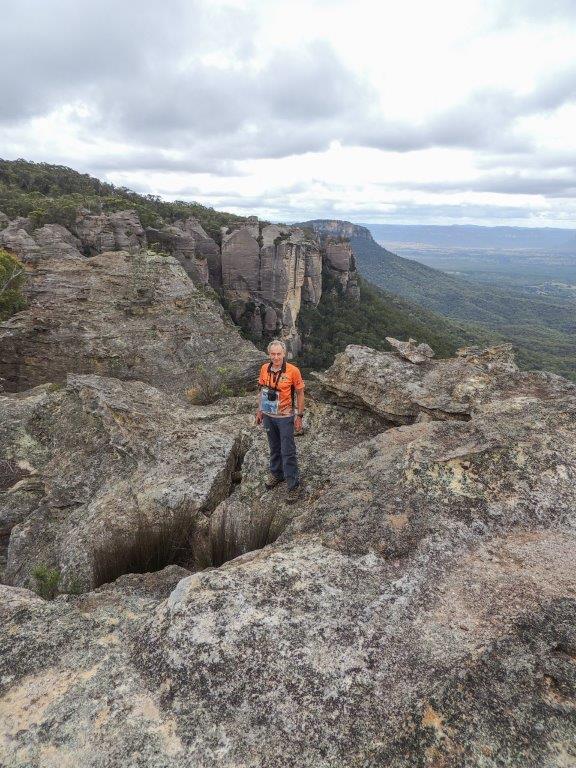
The Citadel
Is a descriptive name for a prominent rock formation on the southernmost extremity of the Genowlan Mountain and the highest point on Citadel Spur. Named by Dr Haydn Washington, November 1984. Ref: Correspondence with David Blackwell, 27th April 2010 and personal correspondence from Haydn Washington 3rd February 2018.
The Cliffs of Mars
Are the northern cliffs which form Constance Gorge and Deanes Creek. Most likely named by Peter Harris, National Parks Association walker, who wrote a report on the area in the NPA journal in the mid 1970s and labelled the photo "The Cliffs of Mars". Peter was also a past president of the Confederation of Bushwalking Clubs. Ref: Correspondence with David Warren Noble, 14th October 2009.
The Crater
Is located 500m north of the Wolgan River between the Pipeline Track and Petries Gully, Newnes. This area morphs from being a cliff surrounded basin to a graduated valley where the cliffs and floor are a continuum. Structurally, The Crater is a hanging valley that enjoys locally higher rainfall and protection from desiccating winds. It is not volcanic in origin and does not even have clay soil. The Tree Ferns areCyathea australis, a species that is more drought tolerant than Dicksonia antarctica. Other common species are Coachwood and Sassafras. Named by Thomas Ebersoll, owner of the Old Newnes Hotel, 2005.
The Dark Side
Of Donkey Mountain refers to the southern side of Donkey Mountain, as in winter it is cold and in shadow for the majority of the daylight hours. This area includes: Impossible Cave, Masterpiece Wall and The Spire. Named by Geoff Fox and Yuri Bolotin on a bushwalk 31 August 2017.
The End of the World
See Deanes Lookout. which was possibly named by David Warren Noble. David also had heard it called The End of the World by local Lithgow people who had previously taken 4WD vehicles into the area. Ref: Correspondence with David Warren Noble, 14th October 2009.
The Five Ladies
Refers to five pagodas clustered together on the northern side of Bungleboori Creek with an elevation of 959m. Named by Hugh Speirs 24th February 2014, in recognition of five ladies from his Bushrangers walking group, Alice Terry, Barb Carfrae, Lotti Heinz, Elaine Browning, and Elizabeth Stark.
The Fort
Is an area of natural rock formations located 2 km south west of Mount Airly and 500m above the Glen Davis Road. Named by Yuri Bolotin and Peter Medbury on a bushwalk 14 June 2021. Yuri recorded, "On top of this natural fortress, marked on the topographic map as spot height 935 m, is a paradise of pagodas, slots, ramps, narrow twisting corridors, dark hidden rooms and unexpected vistas".
The Gloriette
Is a small, intimate canyon located in a tributary of Rocky Creek, 1.2km north east of Mount Budgary. Michael Keats on a Bush Club walk, 28th February 2009 recorded, " This place deserves a name commensurate with its glory."
The Governor
Is a long, 40m high pagoda slope which includes Michaels Chair. It is located 750m west of the road intersection of GlowwormTunnel Road and Fire Trail No. 7. Named by Michael Keats on a Bush Club walk, 21st September 2007. Name relates to the steam railway days, when the Glowworm Tunnel Road was the steam line to Newnes (Wolgan Valley Railway). A governor is a regulator mechanism fitted to stationary steam engines.
The Great Wall of China
Runs along the cliff edge above Gindantherie Pinnacle. Ref: Tom Brennan's photo gallery, 25-26 September 2004.
The Great Zig Zag *
Also known as Zig Zag Historical Railway, is located between Clarence and Lithgow. It is a historic railway line by which the Main Western Line could scale down the western escarpment of the Blue Mountains Range via a series of reversals or "Zig Zags". Opened in 1869, the Zig Zag was a major civil engineering feat for its day. Steam locomotives had to work hard to climb its steep grades. Over time, due to the dependence on rail traffic, this section was a liability and became an operational bottle neck. The Zig Zag was by passed in 1910 by a ten tunnel deviation.
The Grotto
Is a short 200m canyon located on the Airly - Genowlan mesa. The top end of the canyon is 460m east of the communications tower, the lower end, accessed from the 4WD track, is 560m east of the tower. Colin (Col) Maxwell Ribaux, former local land owner, had set up a number of successive handrails and planks within this canyon. The Grotto is a small waterfall and would have been the end of this canyon, if it were not for the ladder Col constructed against a tree to negotiate the exit out of this canyon. Note: the ladder was removed in May 2013 by NPWS.
The Gurgler
Is located 1.1km north west of the road intersection of Glowworm Tunnel Road and Old Coach Road. Named by Michael Keats on a Bush Club walk, 21st September 2007, due to this little valley being amazingly tight.
The Hammer
Refers to an area of land shaped like a hammer head, located on the eastern extremity of Genowlan Mountain mesa. Named by Michael Keats on a Bush Club walk, 9th - 11th November 2010. The aerial view is like the head of a claw hammer.
The Keel
Resembling the keel of a ship is about 80m long, 2m wide and drops about 25m from the plateau into an unnamed tributary of December Creek. So named by Michael Keats and Yuri Bolotin on the 18th January 2013 in keeping with the theme (see) The Barnacles.
The Labyrinth
Is a 500sqm maze centred around the ridge that runs across the northern section of Koopartoo Mesa. It is centred at GR 418 235. Eldorado Traverse is on the north western side, Silver Slot and Diamond Ramp are on the north eastern side and the top of Ariadne Thread on the southern side. Named by Yuri Bolotin on a Bush Club walk 6th April 2017.
The Labyrinth View East
The Labyrinth is a 500sqm maze positioned around the ridge that runs across the northern section of Koopartoo Mesa. Yuri Bolotin on a bushwalk on 22 August 2017 named The Labyrinth View East as an exceptional view point located on the eastern side of The Labyrinth. Named in keeping with the mythology theme names related to the Minotaur, Ariadne Thread, etc.
The Labyrinth View West
The Labyrinth is a 500sqm maze positioned around the ridge that runs across the northern section of Koopartoo Mesa. Yuri Bolotin on a bushwalk on 22 August 2017 named The Labyrinth View West as an exceptional view point located on the western side of The Labyrinth. Named in keeping with the mythology theme names related to the Minotaur, Ariadne Thread, etc.
The Lost City
Is so named due to the remoteness of the pagodas and resemblance to a lost city. Named by Col Ribaux during his diamond mine construction period, 1961-1975. Ref: letter from Col to Capertee Valley Alliance March 2011.
The Lost City
Refers to the maze of pagodas and area of domes near Point Cameron on the Wolgan – Capertee Divide. Ref: David Noble’s blog, 9th July 2013.
The Meadows Trail
Is a 4WD track, 7.5km in length, joining the Crown Creek Trail and leading to Red Rock Trail. Named after the property name,The Meadows , as the trail roughly follows its eastern and southern boundaries.
The Pentacle
The Pondage
Is located roughly midway between Point Cameron and Mount Davidson (Wolgan Trig). So named due to the flat sandy area about 40m x 25m formed in a depression. Usually dry, but during the very heavy rains in early 2012 it filled to a depth of hal fa metre. Most likely named by Coast and Mountain Bushwalking Club member Jeff Howard, c1987. He records,"The place always looked like a dried up Pond with its large dead trees (some of which have now collapsed)."This feature has also been recorded as Newnes Pondage and Dead Tree Camp.
The Pondage Canyon
The Pondage Canyon is is located 600 meters north west of Mount Davidson and 600 meters south of Point Cameron and 100 meters south west of The Pondage. It is about 150 metres long. The first 100 metres can be walked quite easily until the canyon floor drops suddenly at a waterfall. The canyon drains water from an area behind Point Cameron known as The Pondage. It appears to be a fairly reliable source of water for bushwalkers exploring the area. The canyon entrance is through a large overhang that would provide excellent shelter in bad weather. There are some very nice canyon formations in the canyon. There are excellent views into the canyon from the cliffs above. Ref: dingogap.net.au/places/the-pondage-canyon
The Presence Table
Is an isolated rocky viewing platform that gives views to the features of Gardens of Stone National Park on the west and to Wollemi National Park on the east. Named by Michael Keats on his Bush Club walk, 31st August 2006. Michael recorded this place was so special that his 'spiritual fibres started to tingle."
The Roaring Forties Cliff Line
Refers to the 7km long cliff line on the western side of the upper Wolgan Valley from GR 310 137 northwards to Cape Horn. Name recorded in Taylor, Pete and Penney, Andrew. The Wolgan Guide, 1984, p.132.
The Room
Refers to a small flat level area within a pagoda like "room" near Point Nicholson. This "room" has been used for camping as it is near the top of the Wolgan - Capertee Divide and is sheltered from the wind. Ref: Tom Brennan's photo gallery, 1-2nd June 2013. 70.
The Sacristy
Is located on the western side and 800m from the start of The Temples of Doom track. Michael Keats, who named this feature on a Bush Club walk, 4th June 2013 in keeping with the temple theme, described it as,"A room, perhaps 20m x15m in area, with 20m high walls. It certainly is a place where nature keeps her sacred vessels and utensils. We were in awe of this magic place. The mosses literally draped over the rocks, the sunlight shone through cracks and bounced off honey coloured rocks, filling the entire space with golden light."
The Serpent
See Garden of Eden
Garden of Eden is a feature within Coach Wood Forest. At its entry, it is almost totally filled with the Soft Tree Fern, Dicksonia Antarctica. Within this enchanted forest, there is a mature Anchor Vine, Palmeria scandens,that has a girth of 20cm and has wrapped itself around a tree very tightly so it formed a spiral ribbed tube nearly one metre high, before it climbed 20m plus into the tree canopy above. This amazing natural sculpture has been dubbed The Serpent. Both features named by Michael Keats and Brian Fox on a Bush Club walk, 20th August 2012. This ravine is located 500m south east of Galah Trig, access via Galah Mountain Road.
Theseus Slot
Is a huge slot, 150 m+ long, with multiple chambers, and within it, is a giant 15 m high human figure-like sculpture. Located 1.1 km west of the Wolgan River and Zobels Gully junction. Named by Yuri Bolotin on a bushwalk, 22 August 2017, in keeping with the mythology theme names related to the Minotaur, Ariadne Thread, etc. Yuri recorded,“Theseus was Ariadne’s lover, whom she gave a ball of red thread so that he could safely find his way back from The Labyrinth, after slaying the Minotaur. It is his statue that adorns the main, middle chamber of the space.”
The Sign of the Ark of the Covenant
Is located within Lost Ark Ravine, 700m north east of the feature, Temples of Doom. An image of a cross is a rock window like aperture within a dome, that when viewed from the correct angle creates the crucifix illusion. Named by Daryl Watson In keeping with local nomenclature on a Bush Club walk, 4th September 2015.
